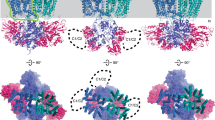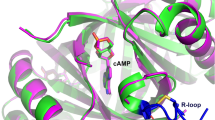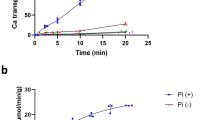Abstract
Increasing evidence suggests that intracellular H+ directly stimulates large-conductance Ca2+- and voltage-activated K+ (SLO1 BK) channels, thus providing a crucial link between membrane excitability and cell metabolism. Here we report that two histidine residues, His365 and His394, located in the intracellular regulator of conductance for K+ (RCK) 1 domain, serve as the H+ sensors of the SLO1 BK channel. Activation of the channel by H+ requires electrostatic interactions between the histidine residues and a nearby negatively charged residue involved in the channel's high-affinity Ca2+ sensitivity. Reciprocally, His365 and His394 also participate in the Ca2+-dependent activation of the channel, functioning as Ca2+ mimetics once they are protonated. Therefore, a common motif in the RCK1 domain mediates the stimulatory effects of both H+ and Ca2+, and provides a basis for the bidirectional coupling of cell metabolism and membrane electrical excitability.
This is a preview of subscription content, access via your institution
Access options
Subscribe to this journal
Receive 12 print issues and online access
$189.00 per year
only $15.75 per issue
Buy this article
- Purchase on Springer Link
- Instant access to full article PDF
Prices may be subject to local taxes which are calculated during checkout






Similar content being viewed by others
References
Lipton, P. Ischemic cell death in brain neurons. Physiol. Rev. 79, 1431–1568 (1999).
Kann, O. & Kovacs, R. Mitochondria and neuronal activity. Am. J. Physiol. 292, C641–C657 (2007).
Higo, T. et al. Subtype-specific and ER lumenal environment-dependent regulation of inositol 1,4,5-trisphosphate receptor type 1 by ERp44. Cell 120, 85–98 (2005).
Austin, C. & Wray, S. Interactions between Ca2+ and H+ and functional consequences in vascular smooth muscle. Circ. Res. 86, 355–363 (2000).
Yao, H. & Haddad, G.G. Calcium and pH homeostasis in neurons during hypoxia and ischemia. Cell Calcium 36, 247–255 (2004).
Chesler, M. Regulation and modulation of pH in the brain. Physiol. Rev. 83, 1183–1221 (2003).
Latorre, R. & Brauchi, S. Large conductance Ca2+-activated K· (BK) channel: activation by Ca2+ and voltage. Biol. Res. 39, 385–401 (2006).
Toro, L. & Stefani, E. Calcium-activated K+ channels: metabolic regulation. J. Bioenerg. Biomembr. 23, 561–576 (1991).
Vergara, C., Latorre, R., Marrion, N.V. & Adelman, J.P. Calcium-activated potassium channels. Curr. Opin. Neurobiol. 8, 321–329 (1998).
Xu, W. et al. Cytoprotective role of Ca2+-activated K+ channels in the cardiac inner mitochondrial membrane. Science 298, 1029–1033 (2002).
Gribkoff, V.K. et al. Targeting acute ischemic stroke with a calcium-sensitive opener of maxi-K potassium channels. Nat. Med. 7, 471–477 (2001).
Tseng-Crank, J. et al. Cloning, expression, and distribution of functionally distinct Ca2+-activated K+ channel isoforms from human brain. Neuron 13, 1315–1330 (1994).
Jiang, Y. et al. Crystal structure and mechanism of a calcium-gated potassium channel. Nature 417, 515–522 (2002).
Jiang, Y., Pico, A., Cadene, M., Chait, B.T. & MacKinnon, R. Structure of the RCK domain from the E. coli K+ channel and demonstration of its presence in the human BK channel. Neuron 29, 593–601 (2001).
Magleby, K.L. Gating mechanism of BK (Slo1) channels: so near, yet so far. J. Gen. Physiol. 121, 81–96 (2003).
Niu, X., Qian, X. & Magleby, K.L. Linker-gating ring complex as passive spring and Ca2+-dependent machine for a voltage- and Ca2+-activated potassium channel. Neuron 42, 745–756 (2004).
Horrigan, F.T. & Aldrich, R.W. Coupling between voltage sensor activation, Ca2+ binding and channel opening in large conductance (BK) potassium channels. J. Gen. Physiol. 120, 267–305 (2002).
Tang, X.D., Santarelli, L.C., Heinemann, S.H. & Hoshi, T. Metabolic regulation of potassium channels. Annu. Rev. Physiol. 66, 131–159 (2004).
Tang, X.D. et al. Haem can bind to and inhibit mammalian calcium-dependent Slo1 BK channels. Nature 425, 531–535 (2003).
Jaggar, J.H. et al. Heme is a carbon monoxide receptor for large-conductance Ca2+-activated K+ channels. Circ. Res. 97, 805–812 (2005).
Schubert, R. & Nelson, M.T. Protein kinases: tuners of the BKCa channel in smooth muscle. Trends Pharmacol. Sci. 22, 505–512 (2001).
Hayabuchi, Y., Nakaya, Y., Matsuoka, S. & Kuroda, Y. Effect of acidosis on Ca2+-activated K· channels in cultured porcine coronary artery smooth muscle cells. Pflügers Arch. 436, 509–514 (1998).
Avdonin, V., Tang, X.D. & Hoshi, T. Stimulatory action of internal protons on Slo1 BK channels. Biophys. J. 84, 2969–2980 (2003).
Church, J., Baxter, K.A. & McLarnon, J.G. pH modulation of Ca2+ responses and a Ca2+-dependent K+ channel in cultured rat hippocampal neurones. J. Physiol. (Lond.) 511, 119–132 (1998).
Lee, K.K., Fitch, C.A., Lecomte, J.T. & Garcia-Moreno, E.B. Electrostatic effects in highly charged proteins: salt sensitivity of pKa values of histidines in staphylococcal nuclease. Biochemistry 41, 5656–5667 (2002).
Ye, S., Li, Y., Chen, L. & Jiang, Y. Crystal structures of a ligand-free MthK gating ring: insights into the ligand gating mechanism of K+ channels. Cell 126, 1161–1173 (2006).
Xia, X.M., Zeng, X. & Lingle, C.J. Multiple regulatory sites in large-conductance calcium-activated potassium channels. Nature 418, 880–884 (2002).
Shi, J. et al. Mechanism of magnesium activation of calcium-activated potassium channels. Nature 418, 876–880 (2002).
Zeng, X.H., Xia, X.M. & Lingle, C.J. Divalent cation sensitivity of BK channel activation supports the existence of three distinct binding sites. J. Gen. Physiol. 125, 273–286 (2005).
Miksovska, J. et al. Distant electrostatic interactions modulate the free energy level of QA- in the photosynthetic reaction center. Biochemistry 35, 15411–15417 (1996).
Bao, L., Rapin, A.M., Holmstrand, E.C. & Cox, D.H. Elimination of the BKCa channel's high-affinity Ca2+ sensitivity. J. Gen. Physiol. 120, 173–189 (2002).
Qian, X., Niu, X. & Magleby, K.L. Intra- and intersubunit cooperativity in activation of BK channels by Ca2+. J. Gen. Physiol. 128, 389–404 (2006).
Cox, D.H., Cui, J. & Aldrich, R.W. Allosteric gating of a large conductance Ca-activated K+ channel. J. Gen. Physiol. 110, 257–281 (1997).
Roosild, T.P., Miller, S., Booth, I.R. & Choe, S. A mechanism of regulating transmembrane potassium flux through a ligand-mediated conformational switch. Cell 109, 781–791 (2002).
Dong, J., Shi, N., Berke, I., Chen, L. & Jiang, Y. Structures of the MthK RCK domain and the effect of Ca2+ on gating ring stability. J. Biol. Chem. 280, 41716–41724 (2005).
Takahashi, K.I. & Copenhagen, D.R. Modulation of neuronal function by intracellular pH. Neurosci. Res. 24, 109–116 (1996).
Kelly, T. & Church, J. pH modulation of currents that contribute to the medium and slow afterhyperpolarizations in rat CA1 pyramidal neurones. J. Physiol. (Lond.) 554, 449–466 (2004).
Filosa, J.A., Dean, J.B. & Putnam, R.W. Role of intracellular and extracellular pH in the chemosensitive response of rat locus coeruleus neurones. J. Physiol. (Lond.) 541, 493–509 (2002).
Decanniere, C., Van Hecke, P., Vanstapel, F., Ville, H. & Geers, R. Metabolic response to halothane in piglets susceptible to malignant hyperthermia: an in vivo31P-NMR study. J. Appl. Physiol. 75, 955–962 (1993).
Denton, J.S., McCann, F.V. & Leiter, J.C. CO2 chemosensitivity in Helix aspersa: three potassium currents mediate pH-sensitive neuronal spike timing. Am. J. Physiol. Cell Physiol. 292, C292–C304 (2007).
Rothman, S.M. & Olney, J.W. Excitotoxicity and the NMDA receptor. Trends Neurosci. 10, 299–302 (1987).
Maingret, F., Patel, A.J., Lesage, F., Lazdunski, M. & Honore, E. Mechano- or acid stimulation, two interactive modes of activation of the TREK-1 potassium channel. J. Biol. Chem. 274, 26691–26696 (1999).
Brelidze, T.I. & Magleby, K.L. Protons block BK channels by competitive inhibition with K· and contribute to the limits of unitary currents at high voltages. J. Gen. Physiol. 123, 305–319 (2004).
Starkus, J.G., Varga, Z., Schönherr, R. & Heinemann, S.H. Mechanisms of the inhibition of Shaker potassium channels by protons. Pflügers Arch. 447, 44–54 (2003).
Derst, C. et al. The large conductance Ca2·-activated potassium channel (pSlo) of the cockroach Periplaneta americana: structure, localization in neurons and electrophysiology. Eur. J. Neurosci. 17, 1197–1212 (2003).
Tammaro, P., Smith, A.L., Hutchings, S.R. & Smirnov, S.V. Pharmacological evidence for a key role of voltage-gated K· channels in the function of rat aortic smooth muscle cells. Br. J. Pharmacol. 143, 303–317 (2004).
Zar, J.H. Biostatistical Analysis (Prentice Hall, Upper Saddle River, New Jersey, 1999).
Tang, X.D. et al. Oxidative regulation of large conductance calcium-activated potassium channels. J. Gen. Physiol. 117, 253–274 (2001).
Santarelli, L.C., Wassef, R., Heinemann, S.H. & Hoshi, T. Three methionine residues located within the regulator of conductance for K+ (RCK) domains confer oxidative sensitivity to large-conductance Ca2+-activated K· channels. J. Physiol. (Lond.) 571, 329–348 (2006).
Long, S.B., Campbell, E.B. & Mackinnon, R. Crystal structure of a mammalian voltage-dependent Shaker family K+ channel. Science 309, 897–903 (2005).
Guex, N. & Peitsch, M.C. SWISS-MODEL and the Swiss-PdbViewer: an environment for comparative protein modeling. Electrophoresis 18, 2714–2723 (1997).
Acknowledgements
We thank M.L. Garcia, Merck Research Laboratories, New Jersey, for the original SLO1 construct and R. Latorre and S. Brauchi, Centro de Estudios Científicos, Valdivia, Chile, for the structural model. Supported in part by the US National Institutes of Health and SFB 604 (TP A4).
Author information
Authors and Affiliations
Contributions
S.H., S.H.H. and T.H. designed the research; S.H., R.X. and T.H. performed the research; S.H., S.H.H., T.H. analyzed the data; S.H., S.H.H. and T.H. wrote the paper.
Corresponding author
Supplementary information
Supplementary Text and Figures
Supplementary Figures 1 and 2 and Supplementary Table 1 (PDF 806 kb)
Rights and permissions
About this article
Cite this article
Hou, S., Xu, R., Heinemann, S. et al. Reciprocal regulation of the Ca2+ and H+ sensitivity in the SLO1 BK channel conferred by the RCK1 domain. Nat Struct Mol Biol 15, 403–410 (2008). https://doi.org/10.1038/nsmb.1398
Received:
Accepted:
Published:
Issue Date:
DOI: https://doi.org/10.1038/nsmb.1398
This article is cited by
-
Human EAG channels are directly modulated by PIP2 as revealed by electrophysiological and optical interference investigations
Scientific Reports (2016)
-
Alcohol withdrawal is associated with a downregulation of large-conductance Ca2+-activated K+ channels in rat inferior colliculus neurons
Psychopharmacology (2014)
-
Structural basis of allosteric interactions among Ca2+-binding sites in a K+ channel RCK domain
Nature Communications (2013)
-
Structure of the gating ring from the human large-conductance Ca2+-gated K+ channel
Nature (2010)
-
Activation of Slo1 BK channels by Mg2+ coordinated between the voltage sensor and RCK1 domains
Nature Structural & Molecular Biology (2008)



